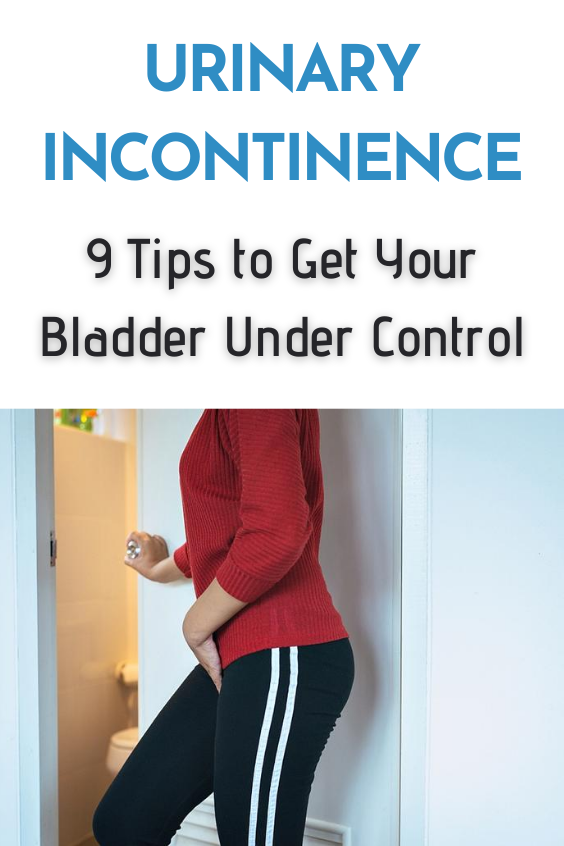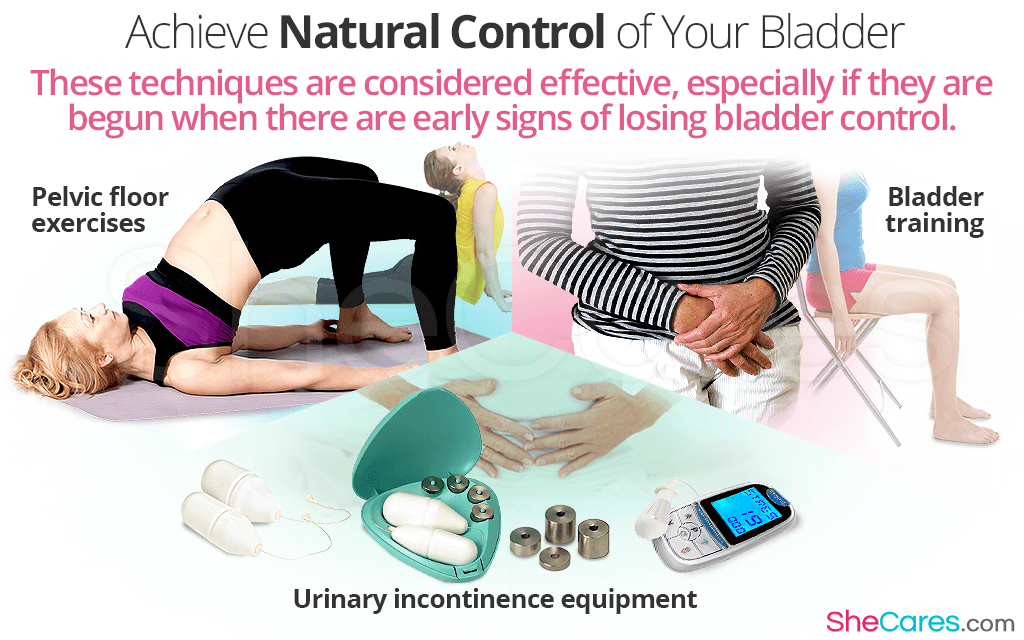Strengthen Your Pelvic Floor Muscles To Improve Urinary Continence
Tackling urinary continence is all about working the pelvic muscles. So why do these muscles matter? The pelvic floor muscles extend from the inside of your pubic bone all the way to your anus and are woven around your urethra, vagina, and rectum. They control the contractions of your bladder muscle as well as the pressure in the urethra. These actions combine to start and stop the flow of a stream of urine. When you contract these muscles, the lower urethra closes and squeezes any urine back up your bladder, preventing leakage. When they relax the urine flows out. If these muscles arent strong, the tightening may not be effective, causing urine to leak. As you exercise these muscles and make them stronger, you should notice less frequent accidents and should be able to go longer without using the bathroom. Doing more repetitions and holding your contractions for longer are other ways to make this more effective.4
Stop Stress Urinary Incontinence With 5 Easy Exercises
Dr. Jen, a pelvic floor physical therapist, shows ways to help reduce & prevent stress urinary incontinence in women & men. This can be caused by coughing, laughing, sneezing, or impact exercises. Buy a worksheet with these exercises: https://www.askdoctorjo.com/stress-urinary-incontinence-worksheet
See more Dr. Jen videos: https://www.youtube.com/playlist?list=PLPS8D21t0eO_tBS1ZA2utq86LexPYADF1
One of the most common issues pelvic floor physical therapists see is stress urinary incontinence. Basically, this is when there is involuntary bladder leakage due to a combination of increased pressure or tension in the abdominal area and weak core muscles.
The main muscles to focus on are the true core muscles which are the respiratory diaphragm, pelvic floor, deep transversus abdominis , and the multifidus muscles in your back. They work together to help stabilize the core, support our organs, and help prevent leakage.
Starting off with proper breathing is the most important part. Holding our breaths during activities increase the pressure which can cause the leaking. Diaphragmatic breathing is not only a great strengthening exercise, but it also helps relax the body as well.
Progressing from there, continue with the diaphragmatic breathing and now add in TA exercises by contracting those muscles as you continue to breathe. Next, adding a gluteus bridge helps progress the movement.
Other Videos Related to the Pelvic Floor:
===========================================
- Rating:
Is Incontinence More Common In Women
Incontinence is much more commonly seen in women than in men. A large part of this is because of pregnancy, childbirth and menopause. Each of these events in a womans life can lead to bladder control issues. Pregnancy can be a short-term cause of incontinence and the bladder control issues typically get better after the baby is born. Some women experience incontinence after delivery because of the strain childbirth takes on the pelvic floor muscles. When these muscles are weakened, youre more likely to experience leakage issues. Menopause causes your body to go through a lot of change. Your hormones change during menopause and this can alter your bladder control.
Men can also experience incontinence, but it isnt as common as it is in women.
Don’t Miss: Medicine For Urinary Tract Infection Male
Pelvic Floor Ball Squeeze
Sit up straight in a sturdy chair with your head lifted and your chin parallel to the ground, shoulders in line with your hips. Place an exercise ball between your thighs. Squeeze the ball and hold for 10 seconds. Repeat 10 times. For a challenge, sit up without leaning back against the chair, Andrews says. This will help strengthen the inner thighs and the abdominal muscles, which intertwine with those pelvic floor muscles and can contribute to better bladder control, Howe says.
Why Do I Leak Urine During My Workouts

Bladder leakage during your workout is due to a condition called Stress Urinary Incontinence . SUI is incontinence that occurs when you have a weak pelvic floor or sphincter muscle, and increased pressure is placed on your bladder. This can happen with things like sneezing, coughing, and, yes, certain forms of working out.
SUI occurs commonly with childbirth, but other conditions can also contribute to the condition. Chronic coughing, surgical procedures, menopause, and obesity can also contribute to SUI.
Recommended Reading: Urinary Tract Infection Treatment Guidelines
Maintain A Healthy Weight
Being overweight or obese can put additional pressure on the pelvic floor muscles, which can lead to stress incontinence. Its important to exercise and eat a diet low in sugar, fat, and calories to lose or maintain weight. Your doctor can refer you to NYU Langones Weight Management Program, where experts can help create a diet plan thats right for you.
Do The Right Exercises
High-impact exercise and sit-ups put pressure on your pelvic floor muscles and can increase leaks.
To strengthen your pelvic floor to relieve symptoms, replace high-impact exercise, such as jogging and aerobics, with strengthening exercise, such as pilates.
Pilates strengthens your core muscles, which is beneficial for stress incontinence.
You May Like: Men’s Urinary Tract Problems
Exercise Your Pelvic Floor
Pelvic floor exercises help strengthen the muscles of the pelvic floor, which support the bladder and urethra and control the flow of urine. These are the muscles you use to hold it in when you have to urinate.
NYU Langone doctors recommend daily Kegel exercises, in which you tighten and release pelvic floor muscles. Your doctor can teach you how to identify these muscles and perform the exercises correctly. He or she can refer you to physical therapists at NYU Langones Rusk Rehabilitation for additional support.
Pelvic floor exercises are recommended for both stress and urgency incontinence.
What Steps Can I Take At Home To Treat Urinary Incontinence
Your doctor or nurse may suggest some things you can do at home to help treat urinary incontinence. Some people do not think that such simple actions can treat urinary incontinence. But for many women, these steps make urinary incontinence go away entirely, or help leak less urine. These steps may include:
You can also buy pads or protective underwear while you take other steps to treat urinary incontinence. These are sold in many stores that also sell feminine hygiene products like tampons and pads.
You May Like: What Remedies For Urinary Tract Infection
How To Practise Pelvic Floor Exercises For Urinary Incontinence
- On April 24, 2018
- 0 Comments
Urinary incontinence remains a topic people are embarrassed to talk about. As a result, many sufferers are unaware that there are non-invasive methods that can strengthen our pelvic floor, such as pelvic floor exercises.
Men and women who are fit and healthy may feel that weak pelvic floor muscles are a health problem faced only by people in old age. This condition is often a taboo topic that we avoid talking about. However, when people find themselves suffering from leakages due to a weak pelvic floor, the need to learn more about the pelvic floor muscles becomes prominent. Statistics from the UK show This Morning show a staggering percentage of women living with pelvic floor problems. The following shocking statistics show just how problematic this lack of understanding is:
42% of women in the UK are sufferers of weak pelvic floor muscles
40% of women are too embarrassed to consult their Doctor
33% of women suffer problems 5 years after childbirth
On average women wait 5 years before consulting their Doctor
Are you worried you have incontinence due to weak pelvic floor muscles?
The Squeeze & Release
The squeeze and release is your secret weapon towards getting your pelvic muscles to respond quickly. This can be very helpful for stopping leaks in pinch!To squeeze and release:
- Sit or stand in a comfortable position and think of the muscles used to control your urine flow.
- Squeeze your pelvic muscles as quickly as possible and rapidly release them with no attempt to hold the position.
- Take a rest for 5 to 10 seconds.
- Repeat contracting your pelvic muscles for 10 to 20 reps.
- Perform this exercise 3 times throughout the day.
You May Like: Bladder Control Products For Urinary Incontinence
How To Do Pelvic Floor Exercises
First, you need to locate your pelvic floor muscles, which you can do by trying to stop your flow of urine mid-stream. Exercises should be performed at first by sitting on a chair with your feet flat on the floor, and your elbows rested on your knees.
Two types of exercises, called slow contraction and fast contraction, should be performed to give your pelvic floor a full workout. Always do the slow contraction exercises first and then the fast contraction exercises.
To practice slow contraction exercises:
- Draw up your muscles surrounding your anus as if you are trying to stop yourself passing gas. However, do not squeeze your buttock muscles.
- Also, draw up the muscles around your urethra as if you are trying to stop urine flow.
- Hold this position for as long as you can. You may only be able to hold this contraction for a couple of seconds at first, but the goal is to hold for a count of 10 seconds.
- Slowly relax and let go for 10 seconds.
- Gradually increase the time you hold the contraction and repeat until your muscles begin to feel tired.
To practice fast contraction exercises:
- Draw up the muscles surrounding your anus and urethra as before.
- Hold the contraction for 1 second and then let go and relax.
- Repeat the contractions up to 10 times or until your muscles tire.
Try to come up with an exercise plan that includes 10 slow contractions and three sets of 10 fast contractions twice per day.
The following tips may help you to increase your success with bladder training:
Do Pelvic Floor Exercises Make A Difference

It takes time, effort and practice to become good at pelvic floor exercises/Kegels. It is best do these exercises for at least three months to start with. You should start to see benefits after a few weeks. However, it often takes two to five months for most improvement to occur. After this time you may be cured of stress incontinence. If you are not sure that you are doing the correct exercises, ask a doctor, physiotherapist or continence advisor for advice.
If possible, continue exercising as a part of everyday life for the rest of your life. Once incontinence has gone, you may only need to do one or two bouts of exercise each day to keep the pelvic floor muscles strong and toned up and to prevent incontinence from coming back.
You May Like: How Do You Get A Urinary Tract Infection From Intercourse
Tighten Your Pelvic Floor With Kegel Exercises
Kegels, or pelvic floor muscle exercises, can benefit both men and women who have urinary incontinence by strengthening the muscles that support the bladder. This, in turn, helps prevent urine leaks and the feeling of urgency that comes with overactive bladder. And Kegels couldnt be easier to do: Per the National Institute of Diabetes and Digestive and Kidney Diseases, simply squeeze or tighten your pelvic floor muscles these are the same muscles you use to stop the flow of urine or passing gas for a count of three and then slowly relax them for a count of three. Kegels are so easy, you can do them anytime even while sitting in your car at a stoplight or at your desk at work. Build up to doing one set of 10 to 15 squeezes, three times a day, and your bladder control should improve within six weeks.
Treat A Chronic Cough
Chronic cough, a cough that lasts eight weeks or longer, can put pressure on the muscles of the pelvic floor and lead to stress incontinence. The most common causes of chronic cough are acid reflux, asthma, postnasal drip, and smoking.
Your NYU Langone doctor may prescribe antihistamines for allergy-related postnasal drip, antacid medications for acid reflux, inhaled steroid medications for asthma, or cough suppressants to help quiet your cough in general. If you smoke, consider quitting, which can stop your chronic cough.
Also Check: Does Apple Cider Vinegar Help Urinary Tract Infections
Urinary Incontinence: Kegel Exercises For Pelvic Muscles
Kegel exercises are one of the best natural ways to control urinary incontinence.
These simple moves can help many women and men, regardless of your age or what’s causing your problem. They strengthen your pelvic floor muscles, which support your bladder. When these muscles are weak, you’re more likely to have leaks.
Here’s what you need to know:
Who benefits from Kegels? Anyone, at any age, who suffers urinary incontinence or leaks urine. While the exercise mainly helps those with stress urinary incontinence, it can also work if you have urge incontinence from overactive bladder. This causes a sudden urge to pee. You might not always make it to the bathroom. Men can do Kegel exercises to control urinary incontinence that can happen after prostate surgery.
How do you do them? Pretend you’re trying to stop the flow of pee. Pull in and squeeze those muscles. Hold the squeeze for about 10 seconds, then rest for 10 seconds. Try for three or four sets of 10 contractions every day.
How do Kegels help? They strengthen the muscles that help control the urethra. When these muscles are weak, you can’t control the flow as well.
When will I see results? It takes time to build your biceps, so it takes time to strengthen pelvic floor muscles, too. Give it 3 to 6 weeks. Do them daily.
Are there other benefits to Kegels? Yes. They can also help you out in the bedroom. When your pelvic floor muscles are in shape, they’ll contract more strongly during an orgasm.
Empty Your Bladder Regularly Even If It Doesnt Feel Full
Going to the bathroom on a schedule, say, every two to three hours, even if you dont feel the urge to urinate is a good idea for people who have urinary incontinence or overactive bladder , Griebling says. Similarly, emptying your bladder before leaving the house or other venues, such as your office or a restaurant, even if you dont feel an urge to go, can diminish leakage and prevent accidents.
You May Like: Tea Tree Oil Urinary Tract Infection
Forms Of Urinary Incontinence
Urinary incontinence is frequently associated with pregnancy and childbirth, menopause or a range of chronic conditions such as asthma, diabetes or arthritis. Its severity can range from an occasional leak when you cough, laugh, lift or exercise to an inability to control your bladder, which may cause you to wet yourself.
Today, four primary forms of incontinence are recognized, each with several potential causes:
How Soon After Starting Kegel Exercises Will Urinary Incontinence Get Better
It may take 4 to 6 weeks before you notice any improvement in your symptoms.10
Kegel exercises work differently for each person. Your symptoms may go away totally, you may notice an improvement in your symptoms but still have some leakage, or you may not see any improvement at all. But even if your symptoms dont get better, Kegel exercises can help prevent your incontinence from getting worse.
You may need to continue doing Kegel exercises for the rest of your life. Even if your symptoms improve, urinary incontinence can come back if you stop doing the exercises.
Don’t Miss: Is Coconut Water Good For Urinary Tract Infection
What Are Kegel Exercises
Kegel exercises, also called pelvic floor muscle training, are simple exercises you can do to treat bladder problems and improve bowel control. The exercises strengthen the pelvic floor muscles that support the bladder, rectum, and uterus. These muscleswhich stretch like a hammock from the front to the back of your pelviscan help you avoid releasing urine, stool, or gas at the wrong times.
What To Expect From Your Doctor

Your doctor is likely to ask you a few questions, such as:
- When did you first begin experiencing symptoms, and how severe are they?
- Have your symptoms been continuous or occasional?
- What, if anything, seems to improve or worsen your symptoms?
- How often do you need to urinate?
- When do you leak urine?
- Do you have trouble emptying your bladder?
- Have you noticed blood in your urine?
- Do you smoke?
- How often do you drink alcohol and caffeinated beverages?
- How often do you eat spicy, sugary or acidic foods?
Don’t Miss: Magnetic Therapy For Urinary Incontinence
What Are The Different Exercises That You Can Try
Practising pelvic floor exercises does not mean you have to go to extreme lengths in buying specialised equipment. In fact, most exercises do not require you to buy anything. Research shows that up to 50% of women trying to do pelvic floor muscle exercises from a pamphlet get the technique wrong. It is therefore important to be aware of how to do the different exercises. Here are a few simple exercises you can try:
Follow Healthy Eating Plan:
One more important thing that can help you prevent urinary incontinence is the food you eat and your eating habits. You should follow a healthy eating plan. However, there is no direct evidence that links nutrition to making the condition of urinary incontinence worse or better.
But, many individuals find that spicy food, chocolate, caffeinated and carbonated beverages, artificial sweeteners, and alcohol, along with highly acidic foods like tomatoes and citrus fruits can contribute to irritation and inflammation of the bladder and can result in urinary incontinence. So, it is better to avoid these drinks and foods and see if you find improvement in your symptoms.
NOTE: Talk to a certified dietitian to know about a healthy eating plan.
Don’t Miss: How To Treat Urinary Urgency